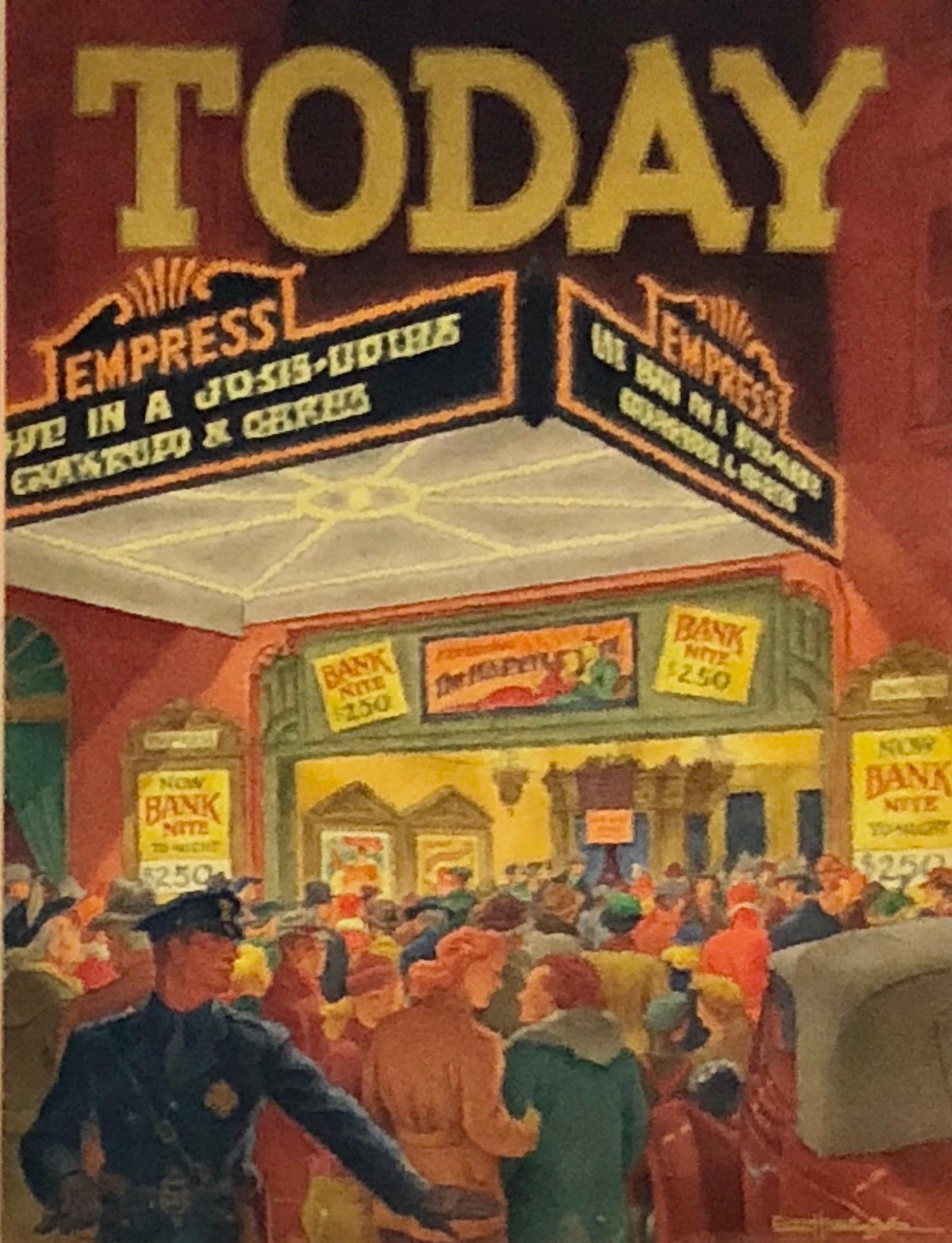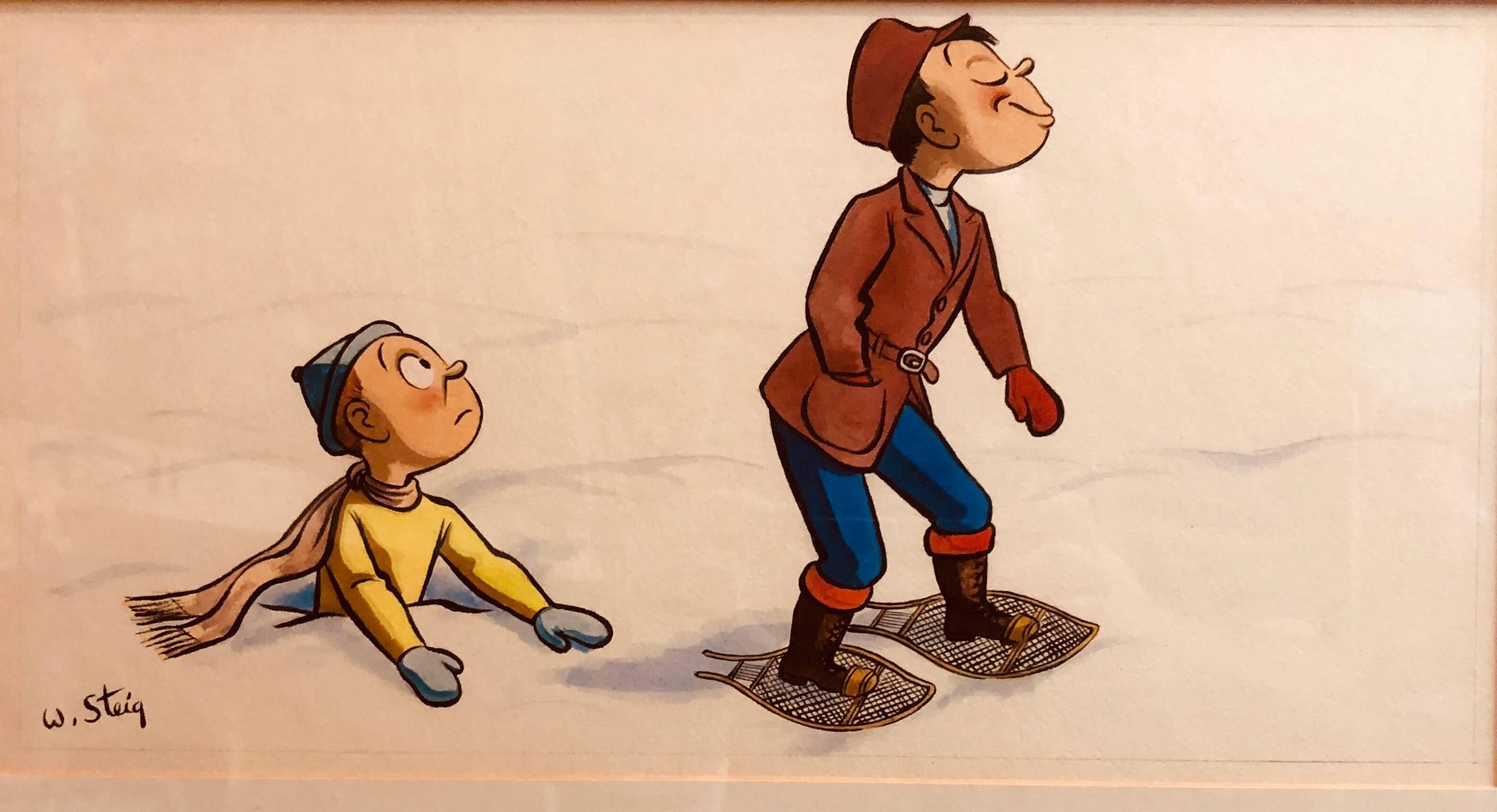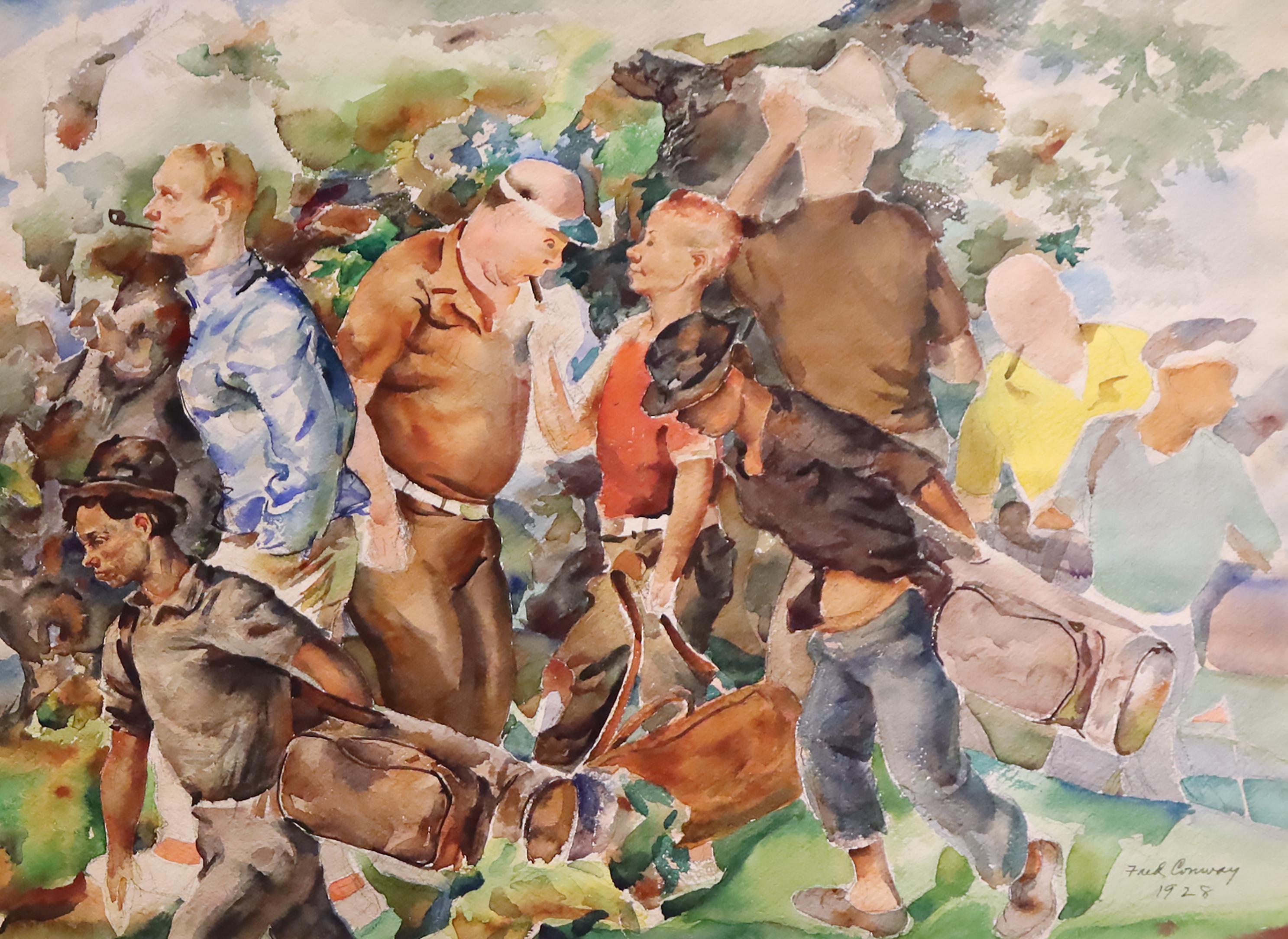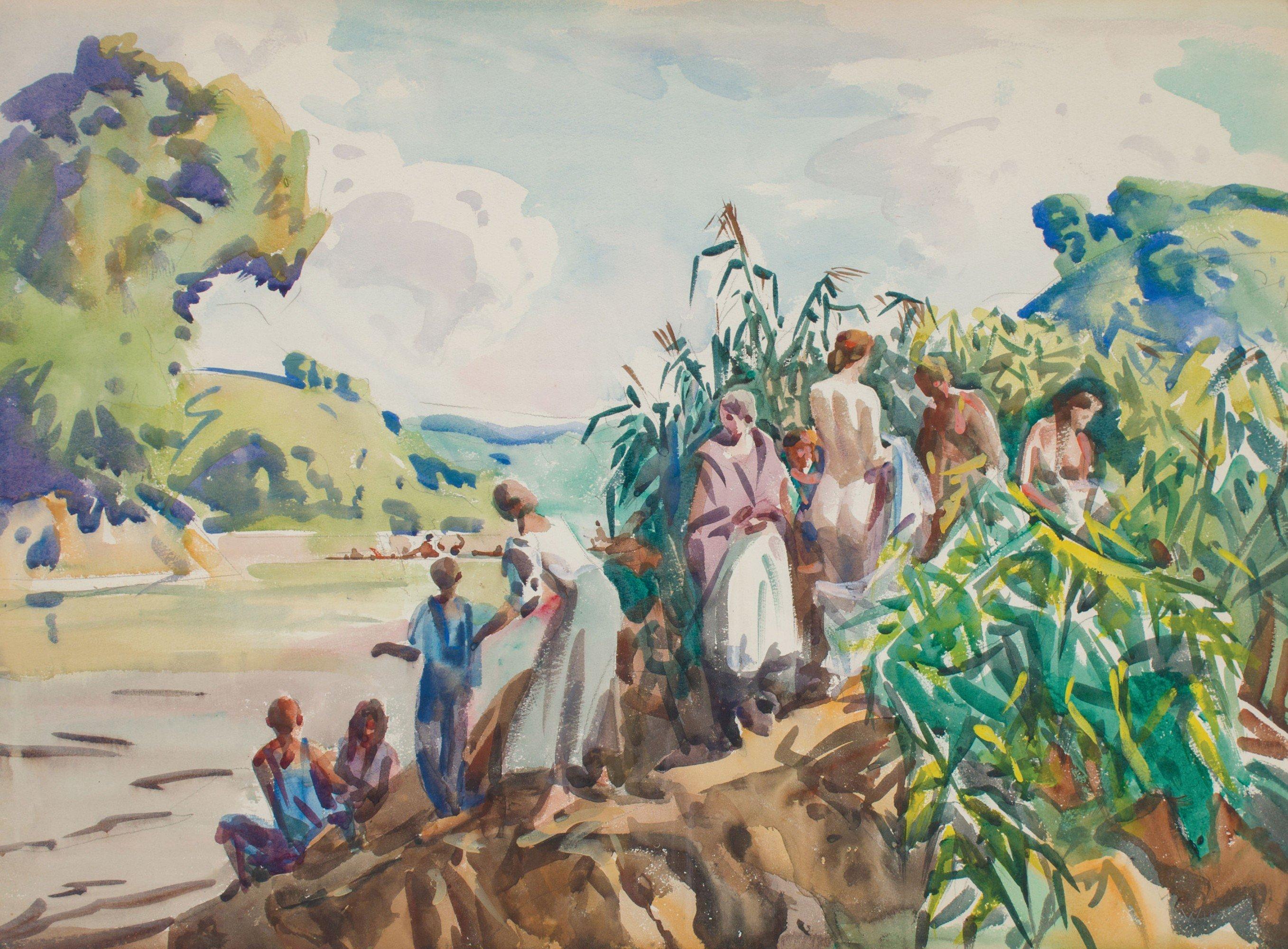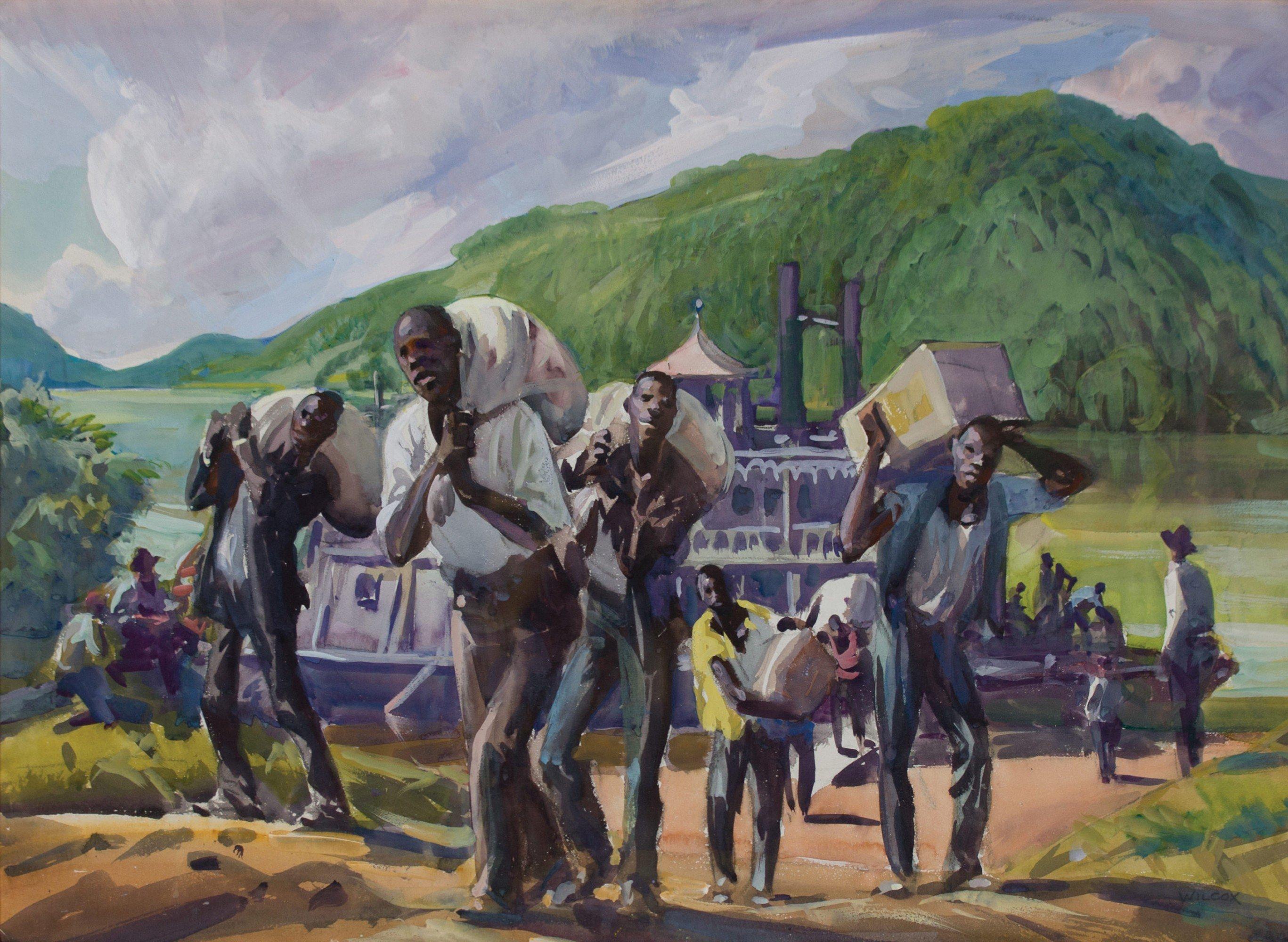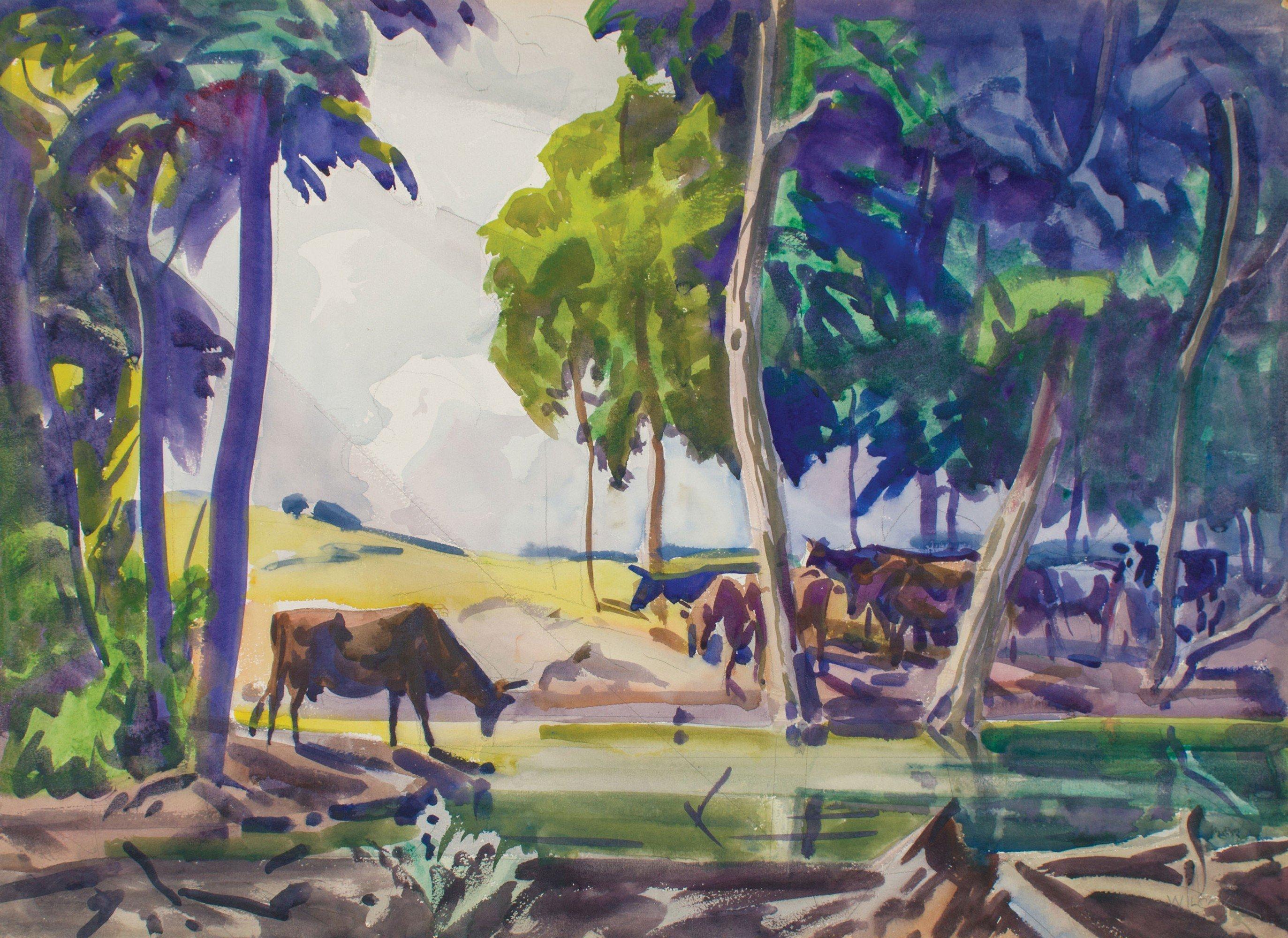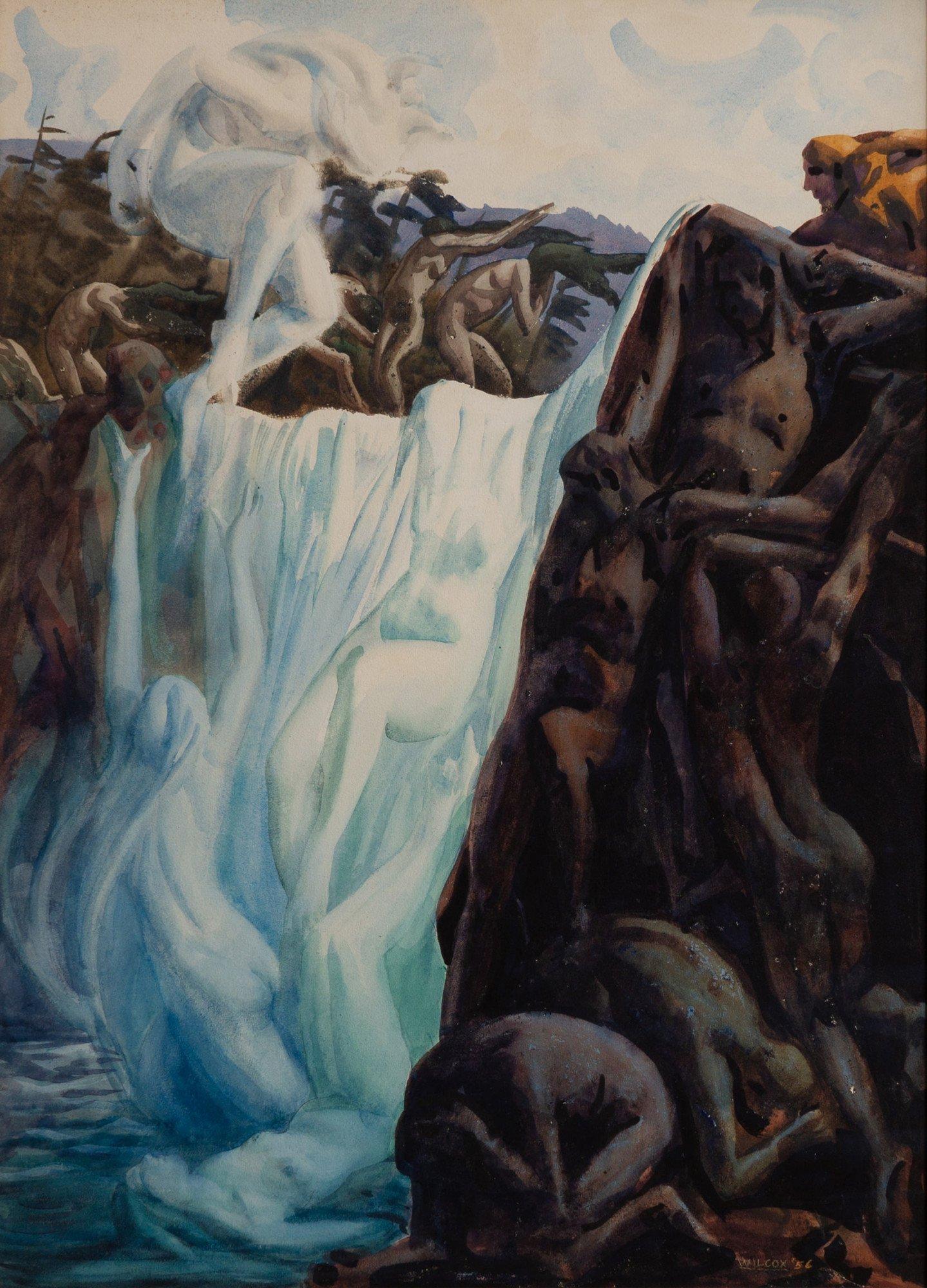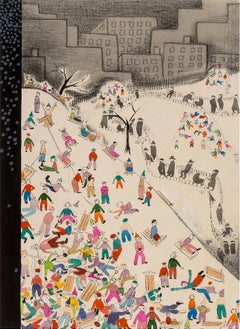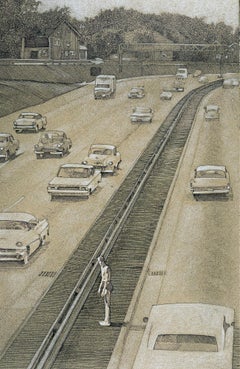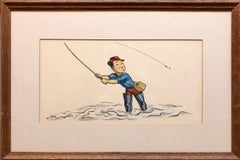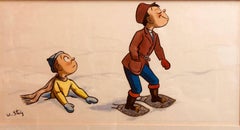
Stop Make Forfeit
View Similar Items
Want more images or videos?
Request additional images or videos from the seller
1 of 3
Addams, Charles SamuelStop Make Forfeit1956
1956
About the Item
- Creator:Addams, Charles Samuel (1912 - 1988, American)
- Creation Year:1956
- Dimensions:Height: 12 in (30.48 cm)
- Medium:
- Movement & Style:
- Period:
- Condition:
- Gallery Location:Miami, FL
- Reference Number:1stDibs: LU38532296543
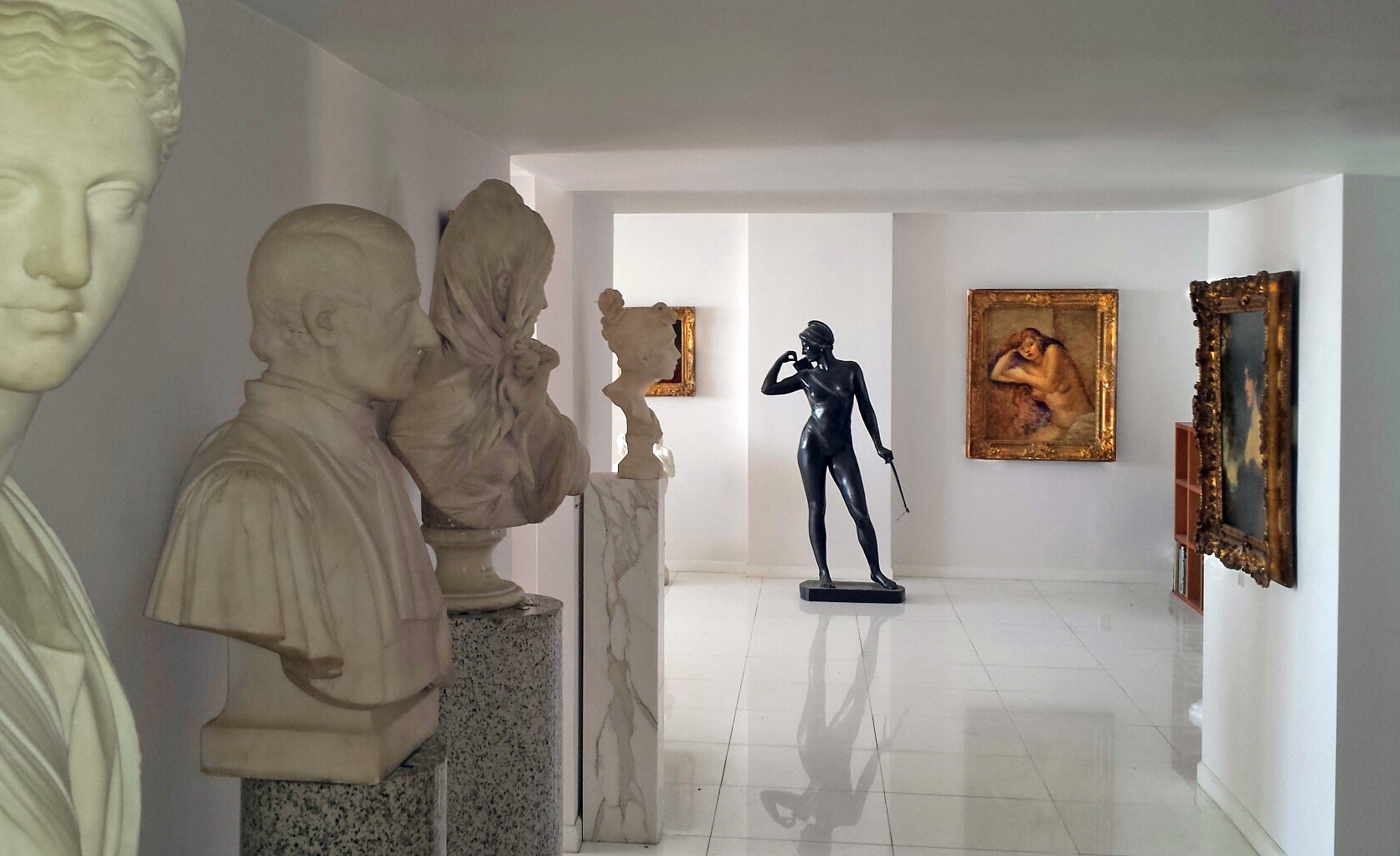
About the Seller
4.9
Platinum Seller
These expertly vetted sellers are 1stDibs' most experienced sellers and are rated highest by our customers.
Established in 2005
1stDibs seller since 2016
102 sales on 1stDibs
Typical response time: 1 hour
More From This SellerView All
- Handsome Couple in Sailboat - Collier's Magazine IllustrationBy Earl Oliver HurstLocated in Miami, FLCollier's Magazine Illustration From the Estate of Charles Martignette. Work is framed in a period wood frame Watercolor on boardCategory
1940s American Modern Figurative Drawings and Watercolors
MaterialsBoard, Watercolor
- Children Snow Sledding in Central Park - New Yorker Cover StudyLocated in Miami, FLHungarian/American artist/illustrator depicts a charming scene of sledding in the snow in Central Park. The work is abstract in its design as it's functional in its narrative - Unpublished New Yorker...Category
1940s Modern Figurative Drawings and Watercolors
MaterialsCharcoal, Ink, Watercolor, Gouache, Pencil
- Surreal semi-Nude Man in the Middle of the HighwayBy Steven StroudLocated in Miami, FLMeticulously rendered surreal image of a seemingly disoriented shirtless and shoeless man standing in the middle of a busy highway and gazing outward. The image is characterized by fine lines with some cross-hatching over a wash mono-chromatic background. Published: The Stories of John Cheever...Category
1980s Surrealist Figurative Drawings and Watercolors
MaterialsPaper, Watercolor, Ink
- Nonconformist Removed by the State. Satyr / Pan MythologyLocated in Miami, FLThis cartoon by Charles Addams is generations ahead of its time. To get the punch line, you need to know the meaning of a Satyr or Pan. Satyr: Part man and part beast. - A male nature spirit with ears and a tail resembling those of a horse, as well as a permanent, exaggerated permanent erection. Early artistic representations sometimes include horse-like legs; Satyrs were characterized by their vulgar, indecent ribaldry, and were rowdy lovers of wine, music, dancing, and women. They inhabited remote locales, such as woodlands, and they often attempted to seduce or rape nymphs and mortal women alike. It's prudish 1950s America, where TV programs show husband and wife sleeping in separate beds. The discussion and representation of sex was repressed. To make a bold statement about censorship and the uncompromising moral climate of the time, Addams uses a reference from the mythical world to make a statement about the real world. In doing so, he anticipates the sexual revolution of the late 1960s and 1970s. The satyr/pan symbolizes nonconformistism. He has his own earthy customs, attitudes, and ideas. Because of that is being handcuffed and formally taken away by the state whose goal is to repress natural erotic fun and frolic that is ubiquitous in todays society. A proper and perfectly pressed Park Ranger cleans out a lustful undesirable from pristine woodlands. With startled expressions, a vulnerable family of correct women witness the event as they are about to have a picnic. The Satyr grasps his Pipes of Pan just over his crotch. The background is populated by phallic symbols. This is one a the rare instances where Addams address the issue of sex. The Ranger is a dead ringer as a self portrait of Addams. Original illustration for a cartoon, showing a uniformed ranger leading away a manacled satyr, in front of a startled picnic party. Ink and grisaille wash on Whatman cold press illustration board, signed "Chas Addams...Category
1950s American Realist Figurative Drawings and Watercolors
MaterialsWatercolor, Ink
- Street Life New York - Haunting Faces Windows Expressionism Mid-CenturyBy Lawrence KupfermanLocated in Miami, FLMid-century artist Lawrence Kupferman paints a madly eerie New York street scene. An exaggerated upward view of two 19th-century walk-ups is split by a forced perspective of a downwa...Category
1940s Expressionist Figurative Drawings and Watercolors
MaterialsInk, Paper, Watercolor, Pen
- Environmental Prognostication Coil Narrative "Homo Sapiens R.I.P."Located in Miami, FL"They paved paradise and put up a parking lot," Joni Mitchell said. - - Created in 1969, at the dawn of the American environmental movement, artist Richard Erdoes draws a sequential narrative in the form of a coil. From inception to destruction, it illustrates a list of things that humans are doing to destroy the world we live in. The work was commissioned for school-age humans and executed in a whimsically comic way. Yet the underlying narrative is sophisticated and foreshadows a world that could be on the brink of ecological disaster. Graphically and conceptually, this work exhibits an endless amount of creativity and Erdoes cartoony style is one to fall in love with. Signed lower right. Unframed 12.4 inches Width: 12.85 inches Height is the live area. Board is 16x22 inches. Richard Erdoes (Hungarian Erdős, German Erdös; July 7, 1912 – July 16, 2008) was an American artist, photographer, illustrator and author. Early life Erdoes was born in Frankfurt,to Maria Josefa Schrom on July 7, 1912. His father, Richárd Erdős Sr., was a Jewish Hungarian opera singer who had died a few weeks earlier in Budapest on June 9, 1912.After his birth, his mother lived with her sister, the Viennese actress Leopoldine ("Poldi") Sangora,He described himself as "equal parts Austrian, Hungarian and German, as well as equal parts Catholic, Protestant and Jew..."[4] Career He was a student at the Berlin Academy of Art in 1933, when Adolf Hitler came to power. He was involved in a small underground paper where he published anti-Hitler political cartoons which attracted the attention of the Nazi regime. He fled Germany with a price on his head. Back in Vienna, he continued his training at the Kunstgewerbeschule, now the University of Applied Arts, Vienna.[5] He also wrote and illustrated children's books and worked as a caricaturist for Tag and Stunde, anti-Nazi newspapers. After the Anschluss of Austria in 1938 he fled again, first to Paris, where he studied at the Academie de la Grande Chaumiere, and then London, England before journeying to the United States. He married his first wife, fellow artist Elsie Schulhof (d. xxxx) in London, shortly before their arrival in New York City. In New York City, Erdoes enjoyed a long career as a commercial artist, and was known for his highly detailed, whimsical drawings. He created illustrations for such magazines as Stage, Fortune, Pageant, Gourmet, Harper's Bazaar, Sports Illustrated, The New York Times, Time, National Geographic and Life Magazine, where he met his second wife, Jean Sternbergh (d. 1995) who was an art director there. The couple married in 1951 and had three children.[6] Erdoes also illustrated many children's books. An assignment for Life in 1967 took Erdoes to the Pine Ridge Indian Reservation for the first time, and marked the beginning of the work for which he would be best known. Erdoes was fascinated by Native American culture, outraged at the conditions on the reservation and deeply moved by the Civil Rights Movement that was raging at the time. He wrote histories, collections of Native American stories...Category
1960s American Realist Landscape Drawings and Watercolors
MaterialsInk, Gouache, Illustration Board
You May Also Like
- Magazine Cover Illustration Mid 20th Century Modern Theatre Broadway Realism WPABy Ernest Hamlin BakerLocated in New York, NYMagazine Cover Illustration Mid 20th Century Modern Theatre Broadway Realism WPA Ernest Hamlin Baker (1889 – 1975) “Today Magazine” Cover ...Category
1930s American Modern Figurative Drawings and Watercolors
MaterialsPaper, Ink, Watercolor, Gouache
- Whimsical Fishing Illustration Cartoon 1938 Mt Tremblant Ski Lodge William SteigBy William Steig (b.1907)Located in Surfside, FLLighthearted Illustration of Outdoor Pursuits This one of a fisherman signed "W. Steig" Provenance: from Mrs. Joseph B. Ryan, Commissioned by Joe Ryan for the bar at his ski resort, Mount Tremblant Lodge, in 1938. Mont Tremblant, P.Q., Canada Watercolor and ink on illustration board, sights sizes 8 1/2 x 16 1/2 in., framed. In 1938 Joe Ryan, described as a millionaire from Philadelphia, bushwhacked his way to the summit of Mont Tremblant and was inspired to create a world class ski resort at the site. In 1939 he opened the Mont Tremblant Lodge, which remains part of the Pedestrian Village today. This original illustration is on Whatman Illustration board. the board measures 14 X 22 inches. label from McClees Galleries, Philadelphia, on the frame backing paper. William Steig, 1907 – 2003 was an American cartoonist, sculptor, and, in his later life, an illustrator and writer of children's books. Best known for the picture books Sylvester and the Magic Pebble, Abel's Island, and Doctor De Soto, he was also the creator of Shrek!, which inspired the film series of the same name. He was the U.S. nominee for both of the biennial, international Hans Christian Andersen Awards, as a children's book illustrator in 1982 and a writer in 1988. Steig was born in Brooklyn, New York in 1907, and grew up in the Bronx. His parents were Polish-Jewish immigrants from Austria, both socialists. His father, Joseph Steig, was a house painter, and his mother, Laura Ebel Steig, was a seamstress who encouraged his artistic leanings. As a child, he dabbled in painting and was an avid reader of literature. Among other works, he was said to have been especially fascinated by Pinocchio.He graduated from Townsend Harris High School at 15 but never completed college, though he attended three, spending two years at City College of New York, three years at the National Academy of Design and a mere five days at the Yale School of Fine Arts before dropping out of each. Hailed as the "King of Cartoons" Steig began drawing illustrations and cartoons for The New Yorker in 1930, producing more than 2,600 drawings and 117 covers for the magazine. Steig, later, when he was 61, began writing children's books. In 1968, he wrote his first children's book. He excelled here as well, and his third book, Sylvester and the Magic Pebble (1969), won the Caldecott Medal. He went on to write more than 30 children's books, including the Doctor DeSoto series, and he continued to write into his nineties. Among his other well-known works, the picture book Shrek! (1990) formed the basis for the DreamWorks Animation film Shrek (2001). After the release of Shrek 2 in 2004, Steig became the first sole-creator of an animated movie franchise that went on to generate over $1 billion from theatrical and ancillary markets after only one sequel. Along with Maurice Sendak, Saul Steinberg, Ludwig Bemelmans and Laurent de Brunhofff his is one of those rare cartoonist whose works form part of our collective cultural heritage. In 1984, Steig's film adaptation of Doctor DeSoto directed by Michael Sporn was nominated for the Academy Award for Best Animated Short Film. As one of the most admired cartoonists of all time, Steig spent seven decades drawing for the New Yorker magazine. He touched generations of readers with his tongue–in–cheek pen–and–ink drawings, which often expressed states of mind like shame, embarrassment or anger. Later in life, Steig turned to children's books, working as both a writer and illustrator. Steig's children's books were also wildly popular because of the crazy, complicated language he used—words like lunatic, palsied, sequestration, and cleave. Kids love the sound of those words even if they do not quite understand the meaning. Steig's descriptions were also clever. He once described a beached whale as "breaded with sand." Throughout the course of his career, Steig compiled his cartoons and drawings into books. Some of them were published first in the New Yorker. Others were deemed too dark to be printed there. Most of these collections centered on the cold, dark psychoanalytical truth about relationships. They featured husbands and wives fighting and parents snapping at their kids. His first adult book, Man About Town, was published in 1932, followed by About People, published in 1939, which focused on social outsiders. Sick of Each Other, published in 2000, included a drawing depicting a wife holding her husband at gunpoint, saying, "Say you adore me." According to the Los Angeles Times, fellow New Yorker artist...Category
1930s American Modern Figurative Drawings and Watercolors
MaterialsIndia Ink, Watercolor, Illustration Board
- Whimsical Illustration "Snow" Cartoon, 1938 Mt Tremblant Ski Lodge William SteigBy William Steig (b.1907)Located in Surfside, FLLighthearted Illustration of Outdoor Pursuits This one being cross country Snow Shoes signed "W. Steig" Provenance: from Mrs. Joseph B. Ryan, Commissioned by ...Category
1930s American Modern Figurative Drawings and Watercolors
MaterialsIndia Ink, Watercolor, Illustration Board
- GolfersBy Frederick ConwayLocated in Missouri, MOGolfers, 1928 Fred Conway (American, 1900-1973) Signed and Dated Lower Right 18.5 x 24.5 inches 30.5 x 37 inches with frame A member of the faculty of the Washington University Art ...Category
1920s American Modern Figurative Drawings and Watercolors
MaterialsPaper, Watercolor
Price Upon Request - Women's Corner, Along the Cuyahoga River, Early 20th Century Cleveland SchoolBy Frank WilcoxLocated in Beachwood, OHFrank Nelson Wilcox (American, 1887-1964) Women's Corner, Along the Cuyahoga River, c. 1916 Watercolor and graphite on paper 21 x 29 inches Frank Nelson Wilcox (October 3, 1887 – April 17, 1964) was a modernist American artist and a master of watercolor. Wilcox is described as the "Dean of Cleveland School painters," though some sources give this appellation to Henry Keller or Frederick Gottwald. Wilcox was born on October 3, 1887 to Frank Nelson Wilcox, Sr. and Jessie Fremont Snow Wilcox at 61 Linwood Street in Cleveland, Ohio. His father, a prominent lawyer, died at home in 1904 shortly before Wilcox' 17th birthday. His brother, lawyer and publisher Owen N. Wilcox, was president of the Gates Legal Publishing Company or The Gates Press. His sister Ruth Wilcox was a respected librarian. In 1906 Wilcox enrolled from the Cleveland School of Art under the tutelage of Henry Keller, Louis Rorimer, and Frederick Gottwald. He also attended Keller's Berlin Heights summer school from 1909. After graduating in 1910, Wilcox traveled and studied in Europe, sometimes dropping by Académie Colarossi in the evening to sketch the model or the other students at their easels, where he was influenced by French impressionism. Wilcox was influenced by Keller's innovative watercolor techniques, and from 1910 to 1916 they experimented together with impressionism and post-impressionism. Wilcox soon developed his own signature style in the American Scene or Regionalist tradition of the early 20th century. He joined the Cleveland School of Art faculty in 1913. Among his students were Lawrence Edwin Blazey, Carl Gaertner, Paul Travis, and Charles E. Burchfield. Around this time Wilcox became associated with Cowan Pottery. In 1916 Wilcox married fellow artist Florence Bard, and they spent most of their honeymoon painting in Berlin Heights with Keller. They had one daughter, Mary. In 1918 he joined the Cleveland Society of Artists, a conservative counter to the Bohemian Kokoon Arts Club, and would later serve as its president. He also began teaching night school at the John Huntington Polytechnic Institute at this time, and taught briefly at Baldwin-Wallace College. Wilcox wrote and illustrated Ohio Indian Trails in 1933, which was favorably reviewed by the New York Times in 1934. This book was edited and reprinted in 1970 by William A. McGill. McGill also edited and reprinted Wilcox' Canals of the Old Northwest in 1969. Wilcox also wrote, illustrated, and published Weather Wisdom in 1949, a limited edition (50 copies) of twenty-four serigraphs (silk screen prints) accompanied by commentary "based upon familiar weather observations commonly made by people living in the country." Wilcox displayed over 250 works at Cleveland's annual May Show. He received numerous awards, including the Penton Medal for as The Omnibus, Paris (1920), Fish Tug on Lake Erie (1921), Blacksmith Shop (1922), and The Gravel Pit (1922). Other paintings include The Trailing Fog (1929), Under the Big Top (1930), and Ohio Landscape...Category
1910s American Modern Figurative Drawings and Watercolors
MaterialsGraphite, Watercolor
- Stevedores, Ohio River, Early 20th Century Cleveland School ArtistBy Frank WilcoxLocated in Beachwood, OHFrank Nelson Wilcox (American, 1887-1964) Stevedores, Ohio River, c. 1920 Watercolor on paper Signed lower right 21.5 x 29. 5 inches "The trip Otto Ege and I made from Pittsburgh to Marietta by riverboat and then by train to Mammoth Cave, was the next high spot in my artistic explorations. We saw something of the Old Southern river life on the way - the roustabouts, the showboat and river town life at Point Pleasant, and then to the sombre tonal mysteries of the Cave. These sights added much to my pictorial vocabulary..." - Frank Wilcox Frank Nelson Wilcox (October 3, 1887 – April 17, 1964) was a modernist American artist and a master of watercolor. Wilcox is described as the "Dean of Cleveland School...Category
1920s American Modern Landscape Drawings and Watercolors
MaterialsWatercolor
